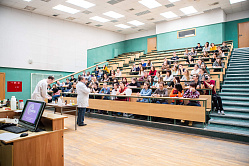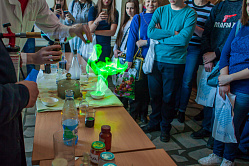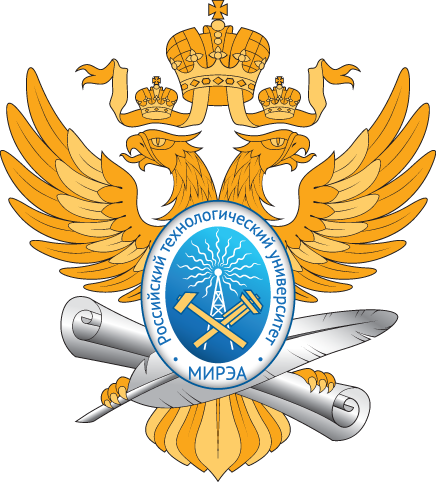History of the Institute
The History of Lomonosov Institute of Fine Chemical Technologies (Lomonosov IFCT) could be divided into four stages: at first, it was the Physics and Mathematics Faculty of the Moscow Higher Courses for Women (1900-1918); later – the Chemistry Department of the 2nd Moscow State University (1918-1930); then followed by the Moscow Institute of Fine Chemical Technology named after M.V. Lomonosov (1930-2015); and finally, with this name the Institute joined MIREA – Russian Technological University.
Interesting facts about the Institute:

Prominent alumni
Over the years, outstanding scholars and researchers, as well as professionals in production, politics and other areas graduated from the Institute. Just to name some of them: Yekaterina Alekseevna Furtseva, Minister of Culture of the USSR; Igor Leonidovich Eremenko, Corresponding Member of the Russian Academy of Sciences, Academician of the Russian Academy of Sciences, Laureate of the State Prize of the Russian Federation; Elena Rafailovna Rossinskaya, specialist in the field of forensic science and forensic examination, Director of the Institute of Forensic Expertise, Moscow State Law Academy; Alexey Eduardovich Voloshin, Deputy Director for Research, Institute of Crystallography named after A.V. Shubnikov RAS; Vladislav Vitalievich Kovriga, Director for Science and Development of JSC "Plant AND Gaztrubplast"; a lot of other prominent scientists and statesmen are alumni of the Institute.
Over the years, outstanding scholars and researchers, as well as professionals in production, politics and other areas graduated from the Institute. Just to name some of them: Yekaterina Alekseevna Furtseva, Minister of Culture of the USSR; Igor Leonidovich Eremenko, Corresponding Member of the Russian Academy of Sciences, Academician of the Russian Academy of Sciences, Laureate of the State Prize of the Russian Federation; Elena Rafailovna Rossinskaya, specialist in the field of forensic science and forensic examination, Director of the Institute of Forensic Expertise, Moscow State Law Academy; Alexey Eduardovich Voloshin, Deputy Director for Research, Institute of Crystallography named after A.V. Shubnikov RAS; Vladislav Vitalievich Kovriga, Director for Science and Development of JSC "Plant AND Gaztrubplast"; a lot of other prominent scientists and statesmen are alumni of the Institute.

The concept of “fine technologies” and its meaning
The word combination “fine technologies” can be interpreted as a way to skillfully manufacture a product, perform the work artistically and close to perfection, with every possible thoroughness and precision, while applying technologies with the understanding of all latent properties and details. This concept is also applied to the chemical industry, hence the term “fine chemical technologies”.
The word combination “fine technologies” can be interpreted as a way to skillfully manufacture a product, perform the work artistically and close to perfection, with every possible thoroughness and precision, while applying technologies with the understanding of all latent properties and details. This concept is also applied to the chemical industry, hence the term “fine chemical technologies”.

The Unique Developments of the Institute
Historically, the Institute has traditionally ranked high among specialized universities and research institutes in terms of the number of implemented inventions. Thus, methods for the production of a number of medicinal drugs were developed and tested on a factory scale, new technologies were introduced for the production of rare elements, synthetic rubbers, adhesive and polymeric materials. During the Great Patriotic War, under the guidance of Nison Gelperin, the Institute professor, the most powerful Soviet aerial bomb at the times of the Second World War was developed.
Alexey Karabash, alumnus of the University, a prominent Soviet chemist is one of the founders of the world's first nuclear power plant in the city of Obninsk. The Institute scholars developed Photohem, the first domestic drug for photodynamic therapy of cancer. Currently, the Institute is also working on innovative projects. For instance, the staff of Lomonosov Institute of Fine Chemical Technologies participated in the development of a new technology to create 3D objects made of photopolymers with nanoparticles.
Historically, the Institute has traditionally ranked high among specialized universities and research institutes in terms of the number of implemented inventions. Thus, methods for the production of a number of medicinal drugs were developed and tested on a factory scale, new technologies were introduced for the production of rare elements, synthetic rubbers, adhesive and polymeric materials. During the Great Patriotic War, under the guidance of Nison Gelperin, the Institute professor, the most powerful Soviet aerial bomb at the times of the Second World War was developed.
Alexey Karabash, alumnus of the University, a prominent Soviet chemist is one of the founders of the world's first nuclear power plant in the city of Obninsk. The Institute scholars developed Photohem, the first domestic drug for photodynamic therapy of cancer. Currently, the Institute is also working on innovative projects. For instance, the staff of Lomonosov Institute of Fine Chemical Technologies participated in the development of a new technology to create 3D objects made of photopolymers with nanoparticles.
- Educational Activity
-
Institutes
- Institute of Information Technologies
-
Institute of Artificial Intelligence
- About the Institute
- Institute Administration
- History of the Institute
-
Training programs
- Bachelor's Degree Programs
-
Master's Degree Programs
- 01.04.02 Applied mathematics and information science
- 09.04.01. Informatics and computer engineering
- 12.04.04 Biotechnical systems and technologies
- 15.04.04 Automation of technological processes and production
- 15.04.06 Mechatronics and robotics
- 27.04.03 System analysis and management
- 27.04.04 Engineering system control
- Infrastructure
- Alumni
- Contacts
- Institute for Cybersecurity and Digital Technologies
-
Institute for Advanced Technologies and Industrial Programming
- About the Institute
- Institute Administration
- History of the Institute
-
Training programs
-
Bachelor's Degree Programs
- 09.03.02 Information systems and technologies
- 11.03.04 Electronics and nanoelectronics
- 12.03.05 Laser technology and laser techniques
- 15.03.01 Mechanical engineering
- 22.03.01 Materials science and technology
- 27.03.01 Standardization and metrology
- 28.03.01 Nanotechnology and microsystems engineering
- 29.03.04 Decorative material working techniques
- 54.03.01 Graphic design
-
Master's Degree Programs
- 09.04.02. Information systems and technologies
- 11.04.04 Electronics and nanoelectronics
- 12.04.02 Optical engineering
- 15.04.01 Mechanical engineering
- 22.04.01 Materials science and technology
- 27.04.01 Standardization and metrology
- 29.04.04 Decorative material working techniques
- 54.04.01 Graphic design
-
Bachelor's Degree Programs
- Infrastructure
- Alumni
- Contacts
- Institute of Radio Electronics and Informatics
- Institute of Management Technologies
- Lomonosov Institute of Fine Chemical Technologies
- Institute of International Education
-
Mega-Laboratories
- Motion Capture Laboratory
- Immersive Technologies Laboratory
- Laboratory for the Development and Transfer of Microfluidic Technologies (DTMT)
- Cell Technologies Megalaboratory operating on the basis of the Department of Chemistry and Technology of Biologically Active Compounds, Medical and Organic Chemistry named after N.A. Preobrazhensky
- General Biotechnology Megalaboratory
- Industry 4.0: Digital Robotized Production center
- Laboratory of Intelligent Autonomous and Multi-Agent Robotic Systems
- Research and Educational Center for Biosynthesis, Isolation and Purification of Monoclonal Antibodies (Generium)
- Rare and Precious Metals Research and Technological Center operating on the basis of the Department of Chemistry and Technology of Rare Elements named after K.A. Bolshakov
- Laboratory of Analytic, Modeling, Design and Digital Prototyping Technologies
- Import Substitution of Information Technologies Educational and scientific testing complex
- Smart Production Systems Educational and Scientific Center
- Elastomers. Thermoplastics. Technologies Educational and Research Center operating on the basis of the Department of Chemistry and Technology of Elastomer Processing named after F.F. Koshelev
- Catalytic and Mass Exchange Processes center
- Center of Innovative Technologies in Microelectronics
- Centre for Additive Polymer Technologies
- Center for Cybersports Robotics
- Mobile Robotics University Laboratory
- Radio electronic Technologies Megalaboratory
- Situation center
- Scientific and Educational Center for Medical Radiology and Dosimetry
- Laboratory of Geographic Information Systems and Technologies
- Educational and Research Center for Space Monitoring ("CosMoCenter")
- Techno-coworking
- Bachelor's Degree Programs
- Master's Degree Programs
- Additional Education Programs
- Physical Education and Sports
© 2025 MIREA - Russian Technological University
